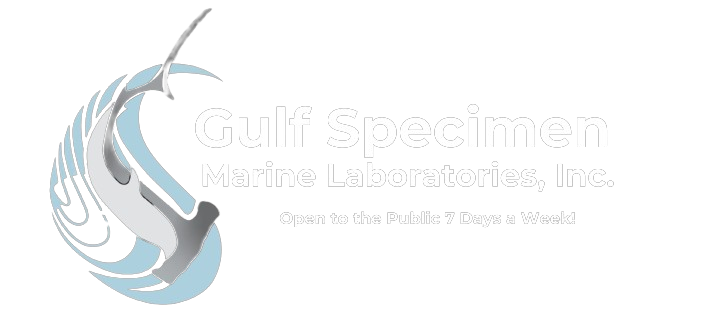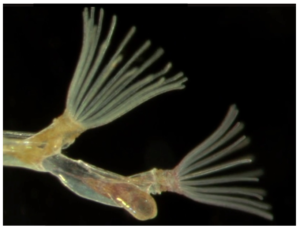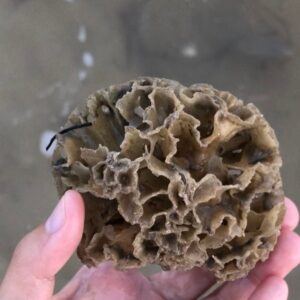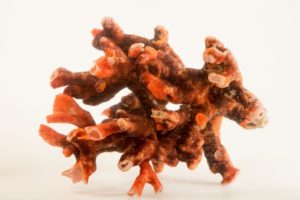Description
h” (Rudloe, 1968). As part of promoting the book I
appeared on the Today television show. I brought specimens
along with me for the show. We also discussed the potential of
developing natural marine drugs. As fate would have it, Dr.
Jonathan L. Hartwell, who headed the US National Cancer
Institute (NCI), caught the show over his breakfast. A few
telephone calls later and I was on a mission: gather some
marine organisms and send them in for testing. I collected a
dozen specimens, put them through a meat grinder and sent
them off, packed in isopropyl alcohol.
Among the specimens was a tiny filter feeding animal
of the bryozoan phylum. This little animal looks like purplish
red seaweed and it is called Bugula neritina. Before this, the
greatest claim to fame the little purple animal had was as an
invasive nuisance. It is a fouling organism that likes to take
over the underside of docks and boats. After I shipped the
ground up parts of this animal to NCI everything about our understanding of Bugula neritina changed.
NCI discovered compounds from the Bugula neritina that stopped cancer in mice. The race was on to
use Bugula neritina to cure cancer.
Research scientists eventually determined that the cancer fighting compound of Bugula neritina
contains some twenty complex molecules called macrolide lactones. These are flat molecules with
multiple rings and side groups. This family of compounds is named bryostatin. It took 30 years before
bryostatin-1 was finally synthesized artificially in 1998. A large number of steps are required to
synthesize bryostatin-1. The result is that even though it can be synthesized, the artificial product
contains impurities (side products) that make it largely unsuitable for use as a medicine.
Bugula neritina actually contains very small amounts of bryostatin and which of the twenty
types of bryostatin depends on where it is harvested. It took 14 tons of Bugula neritina collected from
deep water off the coast of California to produce 18 grams of pure bryostatin-1 for cancer trials by
NCI. The GSML collected Bugula neritina from the Gulf of Mexico contains bryostatins 4,5,6,7 and 8.
A further complication is that the amount of bryostatin produced by Bugula neritina at any given time
also varies. Some batches of Bugula neritina will give high yields while another batch collected at the
same location at another time will give none. Bugula neritina is also a seasonally available creature.
Sometimes there is so much Bugula neritina available it is easy to get pounds of it. A week later it
might be impossible to find. GSMLs special knowledge of when and how to harvest Bugula neritina is
critical for researchers. Over the 2017 Christmas break we collected and shipped 100 pounds of
Bugula neritina to a pharmaceutical development company. We had two scientists independently come
and visit us in order to learn about Bugula neritina. Scientists and researchers still need fresh Bugula
neritina from the sea. GSML is ready to provide it.
Unfortunately, as is so often the case, the early promise of bryostatin-1 did not get translated
into working medicines. Bryostatin-1 did not so much cure cancers as halt their growth as long as the
patient kept taking the drug. The cancer growth would resume once the treatment was stopped. Side
effects, especially severe muscle pain, meant patients could not tolerate the treatment even though it
stopped the cancer. Bryostatin-1 thus fell out of favour as a cancer drug. Nonetheless, research
continued. There has been an explosion in our understanding how cells work since 1968. The level of
our knowledge has doubled every year and been marked by milestones like the sequencing of the
human genome in 2000. Back in 1968, it was not
possible it know how bryostatin-1 actually worked.
Today, we know exactly what bryostatin-1 does.
Every cell in the body of virtually all living
things (except bacteria) contain a membrane bound
protein called Protein Kinase C or PKC for short. PKC
acts as a signalling molecule between the outer
membrane and the nucleus. When PKC is activated it
leaves the membrane and travels down and binds to
various receptors triggering entire cascades of signalling
molecules in the nucleus. This in turn affects which
genes are expressed and by how much. Different cell
types have different variants of PKC. Bryostatin-1 is a
PKC activator causing a rapid release of PKC from the membrane and that in turns sends it off to be
degraded. So by activating the PKC, bryostatin-1 turns off PKC signalling after an initial short boost.
Bryostatin-1 works especially well on the type of PKC that exists in nerve and brain cells.
Scientists found that differences in PKC functioning are directly related to disease in humans.
PKC malfunctioning is known to be a major cause of Alzheimer’s disease. As soon as researchers saw
the connection between PKC and disease, they went looking for PKC activators and they rediscovered
bryostatin-1. Early human trials have show that bryostatin-1 reverses symptoms of Alzheimers in some
patients. Because of the PKC-brain connection, bryostatin-1 is also being tested as a treatment for
people with Fragile X syndrome and
Parkinson’s Disease. PKC activation is
furthermore required in awakening the
immune system so another exciting area of
research is the use of bryostatin-1 to activate
T cells in the immune system. This activates
and exposes cells carrying latent HIV
infection so that the infection can be
destroyed in the body with other drugs. This
has the potential to effectively cure AIDS by
getting rid of all the virus in the body. As of
February 2018 there were some 14,700
Bugula/bryostatin patents according to
Google Patents. Google Scholar shows over 20890 scientific articles on bryostatin and Bugula.
As research continued, scientists also learned that it wasn’t the actual Bugula neritina animal
that was producing the bryostatin. Inside the Bugula neritina are numerous symbiotic bacteria called
Candidatus Endobugula sertula. Unfortunately this bacteria cannot survive outside of the Bugula
neritina animal in a laboratory culture. The bacteria produce bryostatin which then collects in the tips
of the adult. Bryostatin coats the swimming larvae when they are released. The bacteria is thought to
produce bryostatin as a noxious substance that discourages fish and other predators from eating the
larvae. When Bugula neritina are mechanically disturbed they appear to almost explode, releasing
clouds of purple red liquid into the water in a
manner reminiscent of a disturbed octopus or
squid. This liquid contains mixtures of
bryostatin along with red and blue pigments
and lots of little larvae. The blue pigments
have been found to have their own
antimicrobial properties which may function
to protect the larvae from fungus and bacteria
and the dark cloud of pigments may hide the
larvae from predators like fish.
The mixture of bryostatin and
pigments released from grinding Bugula
neritina may have curative and restorative
properties. When we were collecting for that
huge order of Bugula neritina we dumped
what we collected into sinks for cleaning and sorting. The sinks also contained two sick remora. We
had isolated the fish for treatment but they were badly off enough that we had assumed they would die
and we needed the tank. Imagine our astonishment when the last of the Bugula neritina was packed and
shipped and the water cleared and we found the two sick fish were completely cured! W e t h i n k
Bugula neritina “blood” in sea water may work as a curative on fish with fungus and bacteria infecting
wounds. We are working on some of our own
experiments to test this. We know that most green sea
turtles actively seek out and eat patches of pure
Bugula neritina. Sea urchins and certain shrimp also
dine on Bugula neritina. Maybe these animal know
something about Bugula neritina that we don’t. We
are also planning on experiments to learn how to
reliably grow large quantities of Bugula neritina so
regular harvests can take place instead of just by the
whim of the sea. Just as researchers have found that
whole plant marijuana has healing properties not
found just in TCH or other single constituents, we
suspect that whole Bugula extract has properties of
interest. We encourage the research community to look at the whole product. We are proud of the role
we played in bringing Bugula to the medical research community. Gulf Specimen Marine Lab is ready
to continue that partnership.
Jack Rudloe with Natalie K Gordon
Selected References
Clamp, A., Jayson, G.C., 2002. The clinical development of the bryostatins. Anti-Cancer Drugs 13(7), 673-683.
Coyne, M.S., 1994. Feeding Ecology of Subadult Green Sea Turtles in South Texas Waters [Master of Science Thesis]. Texas A&M University.
Halford, B., 2011. The bryostatins’ tale. With the promise of treating cancer, Alzheimer’s, and HIV this family of marine natural products continues t
intrigue scientists more than four decades after its discovery. Chemical & Engineering News 89(43), 10-17.
Nelson, T.J., Alkon, D.L., 2009. Neuroprotective versus tumorigenic protein kinase C activators. Trends in Biochemical Sciences 34(3), 136-145.
Nelson, T.J., Sun, M.K., Lim, C., Sen, A., Khan, T., Chirila, F.V., Alkon, D.L., 2017. Bryostatin effects on cognitive function and PKCɛ in Alzheimer’s
disease phase IIa and expanded access trials. Journal of Alzheimer’s Disease 58(2), 521-534.
Ruan, B.F., Zhu, H.L., 2012. The chemistry and biology of the bryostatins: Potential PKC inhibitors in clinical development. Current Medicinal Chemistry
19(16), 2652-2664.
Rudloe, J., 1968. The Sea Brings Forth. Alfred A. Knopf, New York.
Sharp, K.H., Davidson, S.K., Haygood, M.G., 2007. Localization of ‘Candidatus Endobugula sertula’ and the bryostatins throughout the life cycle of the
bryozoan Bugula neritina. ISME Journal 1(8), 693-702. (Lifecycle figure from this article)
Trindade-Silva, A.E., Lim-Fong, G.E., Sharp, K.E., Haygood, M.G., 2010. Bryostatins: biological context and biotechnological prospects.Current Opinion
in Biotechnology 21834-842. (Bryostatin article from this article.)





